12 Best Remote Team Management Tools for 2025
- Ron Smith

- Jul 13
- 20 min read
The landscape of work has fundamentally shifted. Remote and hybrid models are no longer temporary adjustments but permanent fixtures, demanding a new class of remote team management tools. For leaders building high-performing global teams, simply managing tasks is not enough. The future lies in leveraging emerging trends in workforce management, embracing contingent labor models, and harnessing advanced technology like AI to gain a competitive edge. This evolution has given rise to a new kind of staff augmentation, focused on accessing top global talent at the most affordable costs.
This guide moves beyond generic feature lists to provide a comprehensive analysis of the essential platforms for 2025. We will explore how specific tools solve the core challenges of distributed work, from seamless communication and project tracking to fostering a cohesive team culture across continents. Whether you're a CTO, HR leader, or engineering manager, understanding this ecosystem is crucial for building a resilient, innovative, and geographically diverse team.
Inside, you will find a detailed breakdown of the leading remote team management tools, organized to help you make an informed decision quickly. Each entry includes:
A practical analysis of its core strengths and limitations.
Specific use cases for different team structures and goals.
Direct links and insightful screenshots to see the platform in action.
Our goal is straightforward: to equip you with the knowledge needed to select the right technology stack, streamline your global operations, and transform how your company scales in this new era of work. Let's find the perfect solution for your team's needs.
1. shorepod
Shorepod represents a paradigm shift in how startups and mid-sized tech companies approach global team building, moving beyond traditional recruitment into the realm of Talent-as-a-Service (TaaS). This platform is engineered not just to find talent, but to provide a comprehensive, end-to-end solution for managing a distributed engineering workforce. It’s an indispensable tool for HR leaders, CTOs, and engineering managers who need to scale quickly and efficiently without the logistical and financial drag of conventional hiring processes. By integrating sourcing, onboarding, payroll, and compliance into a single, cohesive system, Shorepod fundamentally redefines what remote team management tools can achieve.
The platform's core strength lies in its ability to deliver pre-vetted, elite engineers from a global talent pool in under 24 hours. This agility is a game-changer for businesses operating at startup speed, enabling them to build specialized teams, like the AWS optimization team Rivian assembled overnight, without missing a beat. This model aligns with emerging trends in workforce management, where access to on-demand contingent labor and specialized skills is paramount for maintaining a competitive edge.
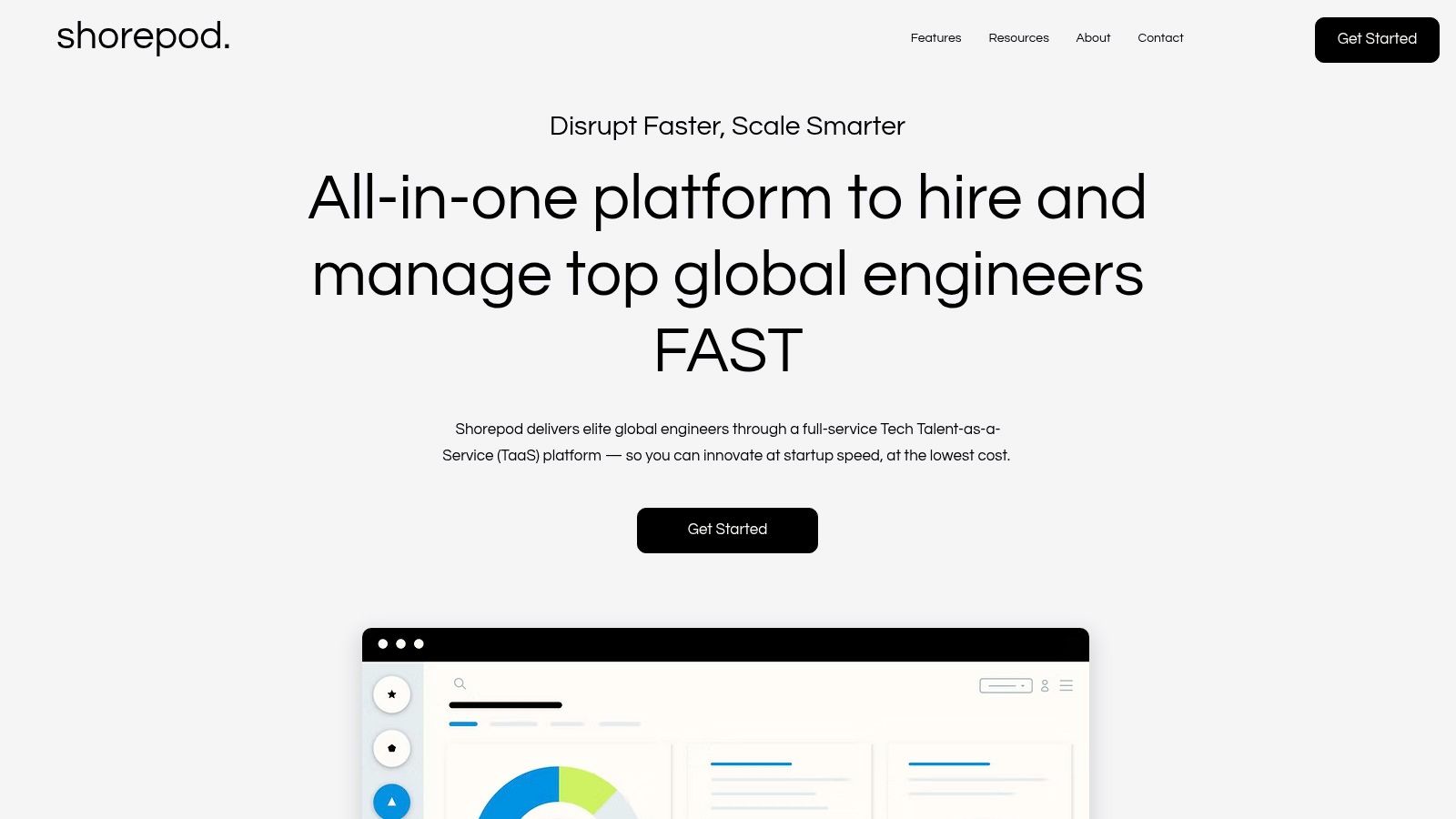
Key Features & Use Cases
Shorepod’s feature set is designed for complete lifecycle management, making it one of the most robust remote team management tools available.
Rapid Talent Deployment: Access a curated pool of global engineers ready to integrate into your projects almost instantly. This is ideal for urgent projects or filling critical skill gaps without the typical 30-90 day hiring cycle.
All-in-One Management Hub: The platform consolidates every administrative function, from timekeeping and milestone tracking to international payroll and benefits administration. This centralized control provides managers with unparalleled visibility and reduces administrative overhead.
Built-in Global Compliance: Shorepod acts as your Employer of Record (EOR), handling complex legal and HR requirements across different countries. This includes worker classification protection, tech insurance, and data security, mitigating the significant risks associated with hiring international talent.
Guaranteed Cost Efficiency: A bold pricing promise guarantees the lowest market rates for top-tier engineers. This new kind of staff augmentation offers the benefits of a global team without the associated high costs, making elite talent accessible at the most affordable cost.
Practical Implementation
To get the most out of Shorepod, leadership should treat it as a strategic growth partner rather than a simple hiring tool. Start by identifying a specific, high-priority project that requires specialized engineering skills. Use this initial engagement to test the platform's rapid deployment capabilities and the quality of its talent pool. For a deeper dive into best practices, Shorepod offers excellent resources; you can discover essential remote management strategies on shorepod.com to complement the platform's features.
Feature | Benefit for Remote Management |
|---|---|
Instant Access to Talent | Eliminates project delays and allows for dynamic team scaling. |
Unified Platform | Simplifies administrative tasks, freeing up managers to focus on strategy and execution. |
EOR & Compliance | Removes legal and financial risks of global expansion. |
Cost Guarantee | Enables budget-conscious scaling with elite, affordable engineering talent. |
Pros:
Access a global pool of elite, pre-vetted engineers ready in under 24 hours.
Comprehensive platform covers the entire hiring and management lifecycle.
Guaranteed lowest cost for top-tier global engineering talent.
Full compliance support, including Employer of Record (EOR) services.
Cons:
As a newer platform, some features may be less mature than long-established competitors.
Primarily tailored for startups and mid-sized companies; may lack deep customization for large enterprises.
Learn More: [Visit shorepod.com](https://www.shorepod.com)
2. Asana
Asana is a work management powerhouse that excels at bringing clarity and structure to complex projects, making it one of the most effective remote team management tools available. It moves beyond simple to-do lists by enabling managers to map out entire project timelines, define dependencies between tasks, and assign ownership with clear deadlines. This level of organization is critical for distributed teams who can't rely on hallway conversations for updates.
For a Head of HR or an Engineering Manager, Asana provides a centralized hub to track everything from onboarding new hires to managing multi-stage development sprints. Its strength lies in its multiple project views, allowing team members to visualize work in the format that suits them best, whether it's a Kanban board for agile workflows, a timeline (Gantt chart) for long-term planning, or a simple list for daily tasks. This flexibility ensures different departments can adapt the tool to their specific processes without friction.
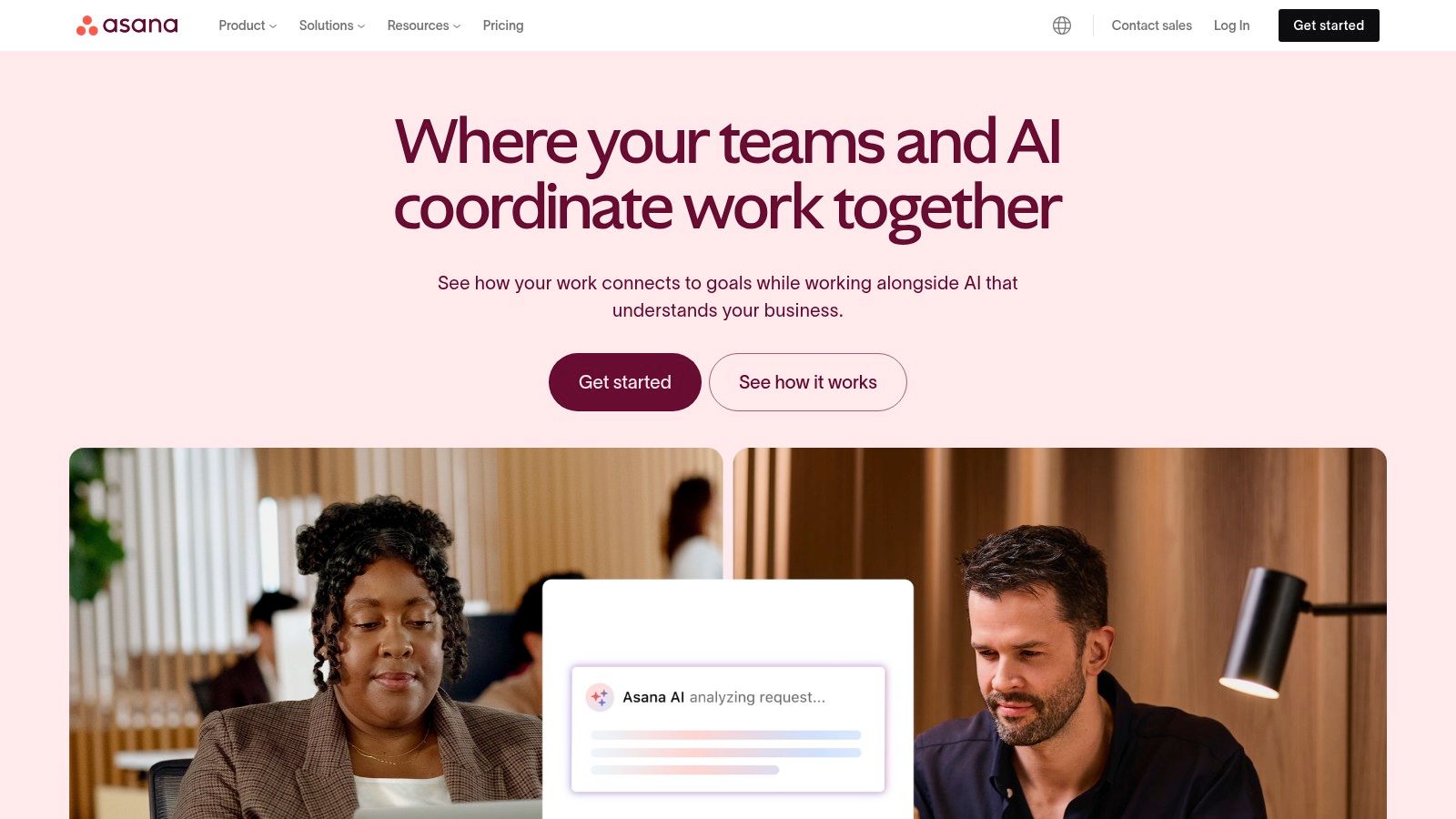
Key Features & Use Cases
Customizable Workflows: Build automated rules to streamline repetitive tasks, like moving a task to the "In Review" column when a file is attached.
Portfolio Management: Gain a high-level overview of all key projects in one place, helping leadership track progress toward strategic goals and allocate resources effectively.
Integrations: Asana connects seamlessly with tools like Slack, Google Drive, and Microsoft Teams, ensuring it fits into your existing tech stack rather than disrupting it.
Analysis and Implementation
While Asana’s user interface is clean and intuitive, its true power is unlocked in its paid tiers. The free version is excellent for small teams or basic project tracking, but lacks the advanced features like timelines, custom fields, and reporting that midsize companies need for robust remote management. One notable limitation is the absence of native time tracking, requiring an integration with a third-party app.
Pro Tip: Use the "Goals" feature to connect daily work directly to company objectives. This helps remote employees see how their individual contributions impact the bigger picture, a key factor in maintaining engagement and motivation in a distributed workforce.
Website: https://asana.com/
3. Slack
Slack is the quintessential communication hub that has fundamentally changed how teams collaborate, making it an indispensable remote team management tool. It replaces fragmented email chains with organized, channel-based conversations, creating a central space for real-time discussions, file sharing, and quick decisions. For remote-first companies, Slack serves as the virtual office floor, a place where culture is built and work gets done transparently.
A Head of HR can use dedicated channels for onboarding announcements, while a CTO can create private channels for sensitive security discussions or public ones for specific engineering projects. Its core strength is bringing context and searchability to communication, eliminating the need to dig through inboxes. This immediate access to information and colleagues is what makes remote teams feel connected and aligned, regardless of their physical location.
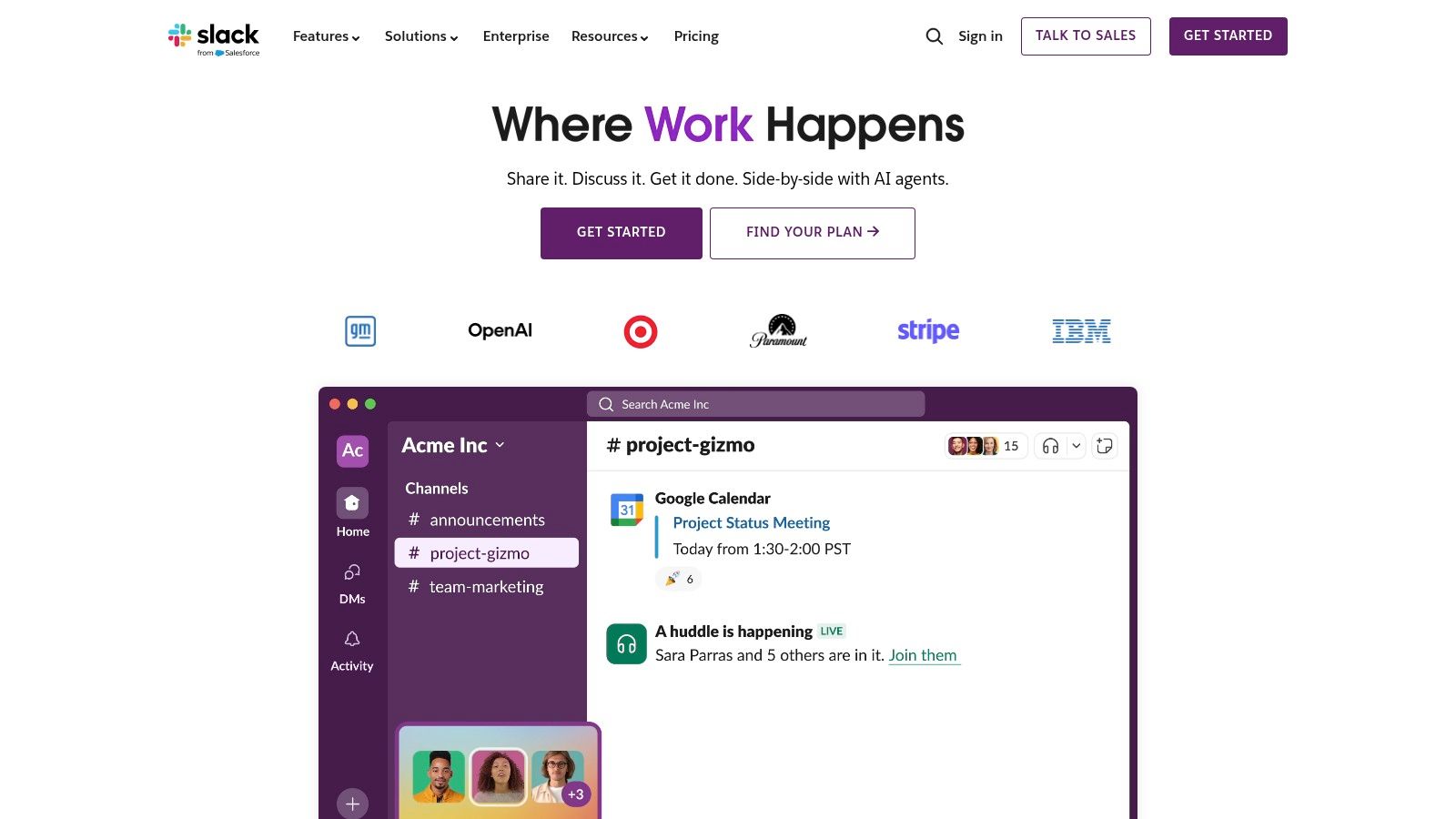
Key Features & Use Cases
Channel-Based Messaging: Organize conversations by project, team, or topic (#dev-team, #q4-marketing-campaign) to keep discussions focused and easy to follow.
Powerful Integrations: With over 2,000 apps, you can receive notifications from Trello, start a Zoom call, or get updates from Google Drive directly within Slack, centralizing your workflow.
Searchable History: Quickly find past conversations, files, and decisions, creating an accessible knowledge base for the entire team.
Analysis and Implementation
Slack's user-friendly interface makes it incredibly easy to adopt, but its true power lies in its integrations and paid features. The free plan is suitable for very small teams but is limited to a 90-day message history, which can be a significant drawback for long-term projects. A major challenge for organizations is "notification fatigue"; without clear guidelines, the constant stream of messages can become overwhelming and counterproductive.
Pro Tip: Use Slack Huddles for quick, spontaneous audio or video conversations to replicate the "just-a-quick-question" moments of an office. This is far more efficient than scheduling a formal meeting for a two-minute chat and helps maintain personal connection.
Website: https://slack.com/
4. Trello
Trello is a highly visual, Kanban-style collaboration tool that simplifies project management into boards, lists, and cards. Its intuitive drag-and-drop interface makes it one of the most accessible remote team management tools, especially for teams that thrive on visual workflow tracking. Instead of complex Gantt charts, Trello provides a clear picture of who is doing what and where each task stands in the project pipeline, which is essential for maintaining alignment in a distributed environment.
For managers, Trello is perfect for overseeing workflows like content calendars, sales pipelines, or simple bug tracking. Its simplicity is its greatest strength; a new hire, whether a full-time employee or part of a contingent workforce, can understand the basics in minutes. This low barrier to entry ensures rapid adoption across different departments, allowing teams to organize and prioritize projects with minimal setup and training. It offers a straightforward approach that contrasts with more feature-heavy platforms.
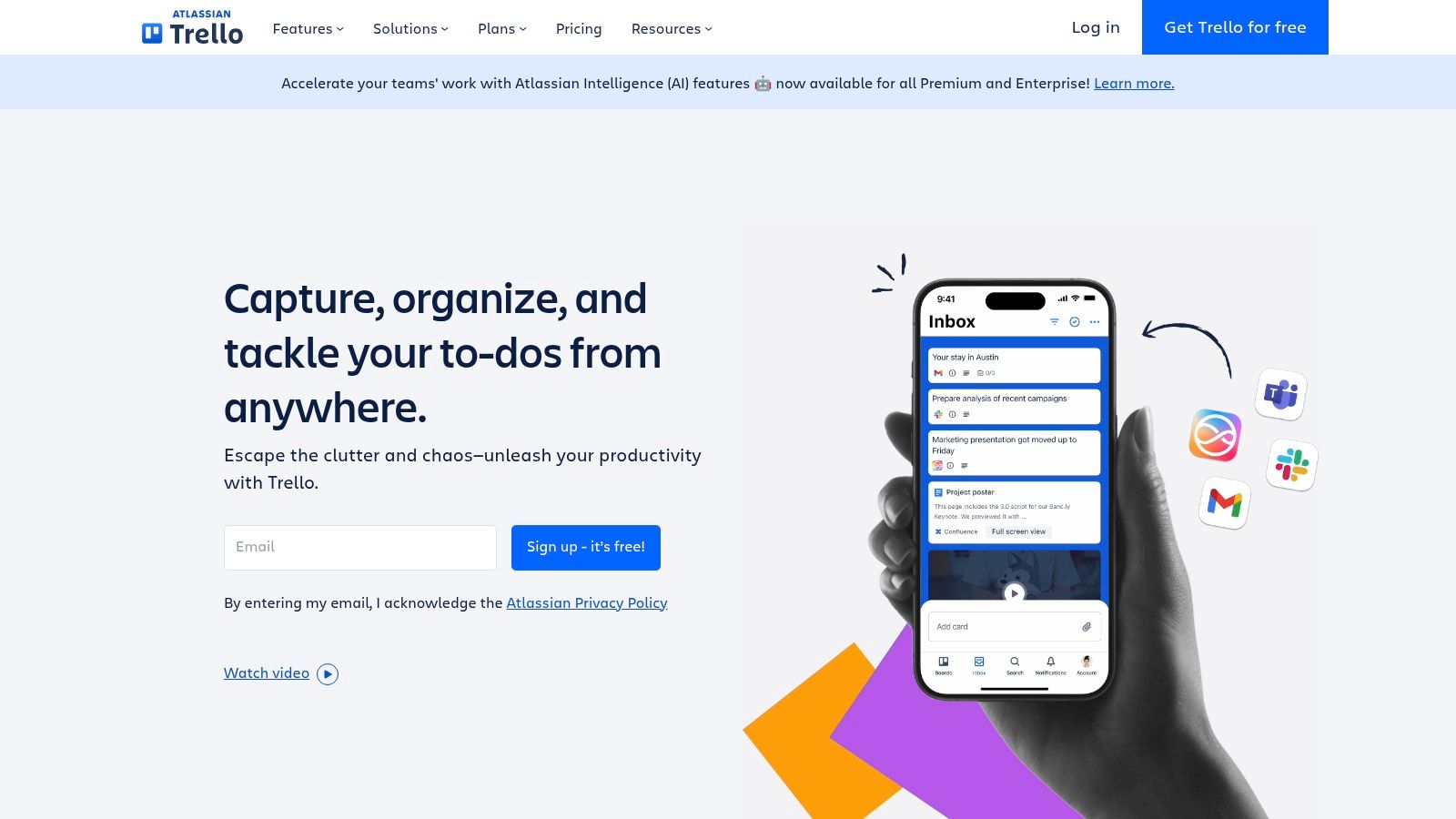
Key Features & Use Cases
Kanban Boards: Visually organize tasks on boards, moving cards through lists like "To Do," "In Progress," and "Done" to track progress transparently.
Butler Automation: Automate repetitive actions with rule-based triggers. For example, automatically assign a team member when a card is moved to the "In Review" list.
Power-Ups: Extend Trello’s functionality by integrating with other apps like Slack, Google Drive, and Jira, adding features like calendars, voting, and custom fields directly to your boards.
Analysis and Implementation
Trello's free version is incredibly generous and suitable for many small teams and startups. However, its visual-first approach can be a limitation for complex project management that requires in-depth reporting, dependency management, or native time tracking. These functionalities often require paid plans and Power-Up integrations. While excellent for task management, it may not suffice as a standalone tool for teams needing robust, high-level portfolio oversight without significant customization.
Pro Tip: Use labels and color-coding to categorize tasks by priority, department, or task type. This adds another layer of visual organization, allowing remote team members to quickly filter boards and focus on their most relevant tasks, reducing digital noise.
Website: https://trello.com/
5. Monday.com
Monday.com positions itself as a "Work OS" (Work Operating System), offering a highly visual and flexible platform that makes it one of the most adaptable remote team management tools on the market. Its core strength lies in its modularity, allowing managers to build custom workflows for virtually any process, from marketing campaign tracking to complex software development cycles. This is particularly valuable for remote teams, where standardized, visible processes are essential to keep everyone aligned and accountable without constant check-ins.
For a CTO managing a global engineering team or a Head of Talent Acquisition coordinating with contingent labor, Monday.com provides a colorful, intuitive, and centralized space. Teams can visualize their work using various views like Kanban, Gantt, calendar, and table formats, ensuring that both high-level strategists and on-the-ground task owners can see information in the way that best supports their role. Its no-code automations are a standout feature, empowering non-technical managers to streamline repetitive administrative tasks and free up valuable time.
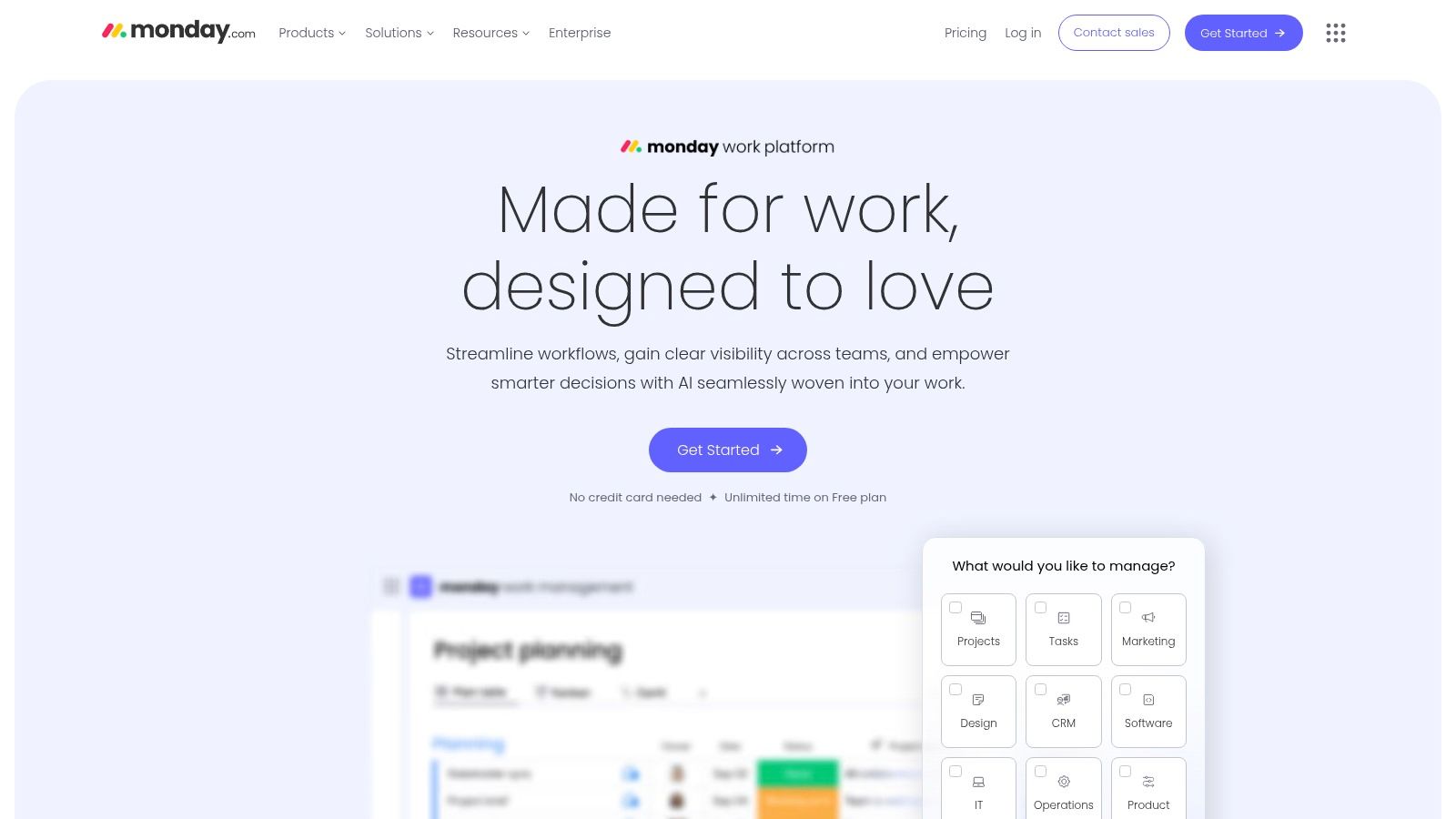
Key Features & Use Cases
Customizable Workflow Automation: Build "if this, then that" automation recipes without any code to handle status updates, notifications, and task creation.
Centralized Dashboards: Create high-level, real-time dashboards that pull data from multiple project boards, giving leadership a clear view of team capacity, project progress, and budget tracking.
Extensive Integrations: Connects with over 200 popular tools, including Slack, Zoom, Google Drive, and Salesforce, to centralize information and create a single source of truth.
Analysis and Implementation
Monday.com’s visual appeal and extreme flexibility are its biggest assets, but they can also be its downfall. The sheer number of features and customization options can be overwhelming for new teams, leading to a steeper learning curve compared to more opinionated tools. Its pricing model, which is based on user "seats" in specific tier blocks, can also become costly for larger teams.
Pro Tip: Leverage Monday.com's pre-built templates for specific use cases like CRM, project management, or recruitment tracking. These provide a solid foundation, allowing you to customize a proven workflow rather than starting from a blank slate, which significantly shortens the implementation time.
Website: https://monday.com/
6. ClickUp
ClickUp positions itself as the "one app to replace them all," and for many remote teams, it comes impressively close. It’s a powerful, all-in-one productivity platform designed to consolidate tasks, documents, goals, and communication into a single, unified workspace. This makes it one of the most versatile remote team management tools by eliminating the need to constantly switch between different applications, reducing context-switching friction for distributed employees.
For a CTO or Engineering Manager, ClickUp offers immense flexibility, allowing them to manage complex sprints using custom statuses while simultaneously providing a high-level Gantt chart view for long-term roadmaps. A Head of HR can build a complete employee onboarding and offboarding process within the platform, using task templates and automations to ensure consistency. This ability to be everything from a simple to-do list to a complex project management system is its core strength.
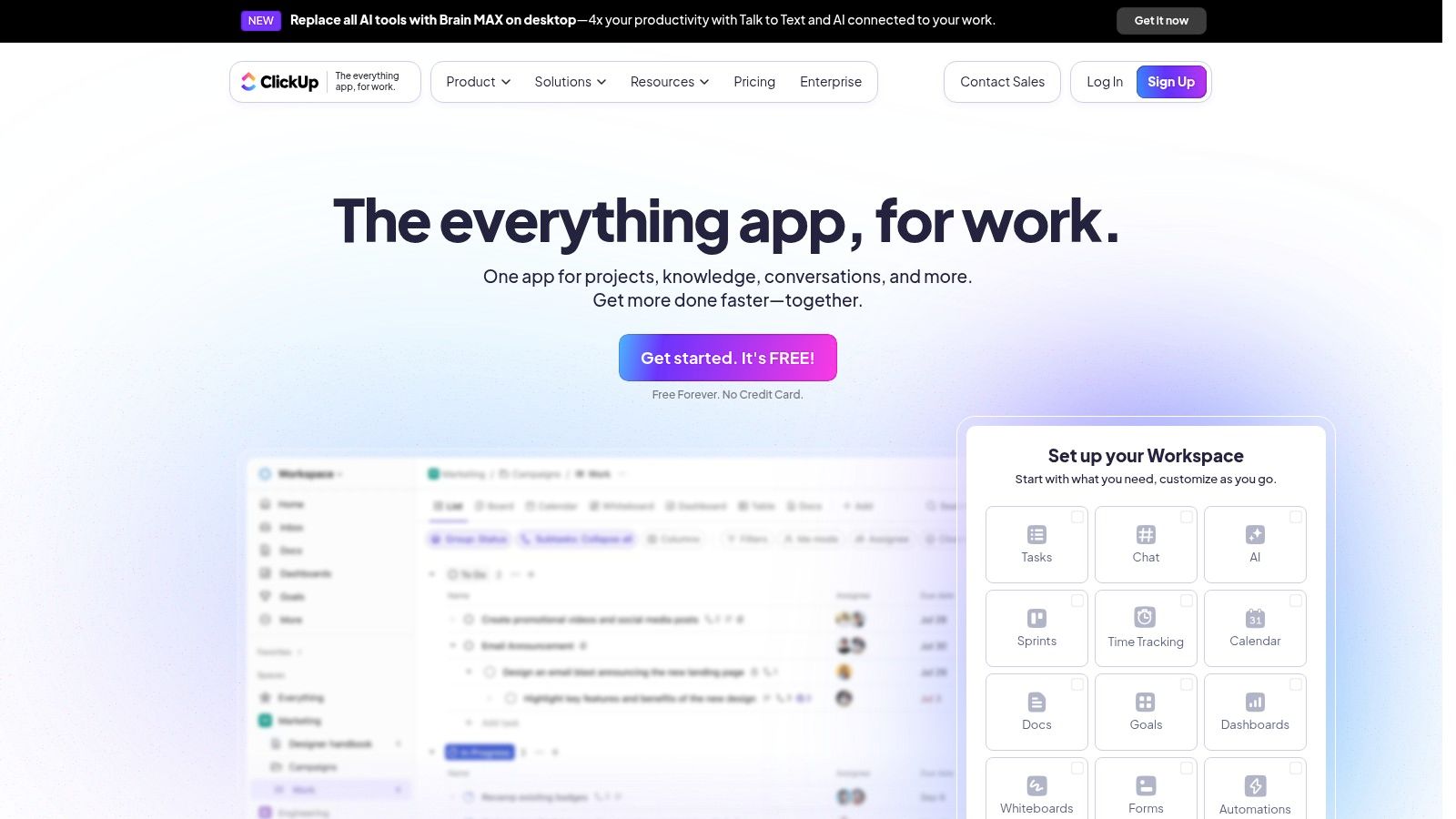
Key Features & Use Cases
Multiple Project Views: Switch between List, Board, Calendar, Gantt, and more to visualize work in the most effective format for any task or team member.
Customizable Tasks: Add custom fields, priorities, dependencies, and detailed statuses to tasks, providing granular control over every aspect of a project.
Integrated Docs & Whiteboards: Create and collaborate on documents and brainstorm visually on whiteboards directly within a project, keeping all context in one place.
Analysis and Implementation
ClickUp's greatest strength, its sheer volume of features, can also be its primary weakness. The platform's extensive customization options can create a steep learning curve, and the interface may feel cluttered or overwhelming for new users. However, its free plan is remarkably generous, offering substantial functionality that rivals the paid plans of many competitors.
Pro Tip: Start with a simple setup and introduce "ClickApps" (modular features) gradually as your team becomes more comfortable. For instance, enable the "Time Tracking" ClickApp only when your team is ready to adopt it, preventing feature overload. This measured approach helps teams harness its power without getting lost in the complexity.
Website: https://clickup.com/
7. Hubstaff
Hubstaff is a powerful workforce analytics and productivity platform that provides concrete data on how remote teams operate, making it one of the most accountability-focused remote team management tools. It addresses a core challenge of distributed work: understanding how time is spent. By combining time tracking with optional activity monitoring, such as screenshots and app usage, it gives managers visibility into team productivity, helping identify bottlenecks and ensure project budgets are on track. This data-driven approach is invaluable for roles like CTOs or Engineering Managers who need to optimize workflows and resource allocation for globally distributed talent.
For organizations leveraging new staffing models like staff augmentation or managing offshore development teams, Hubstaff provides a layer of trust and transparency. It moves beyond simple task completion to offer insights into effort and focus, which is crucial when direct oversight is not possible. The platform’s ability to automate timesheets and link hours directly to payroll simplifies administrative burdens, a significant benefit for HR departments managing a diverse, contingent workforce.
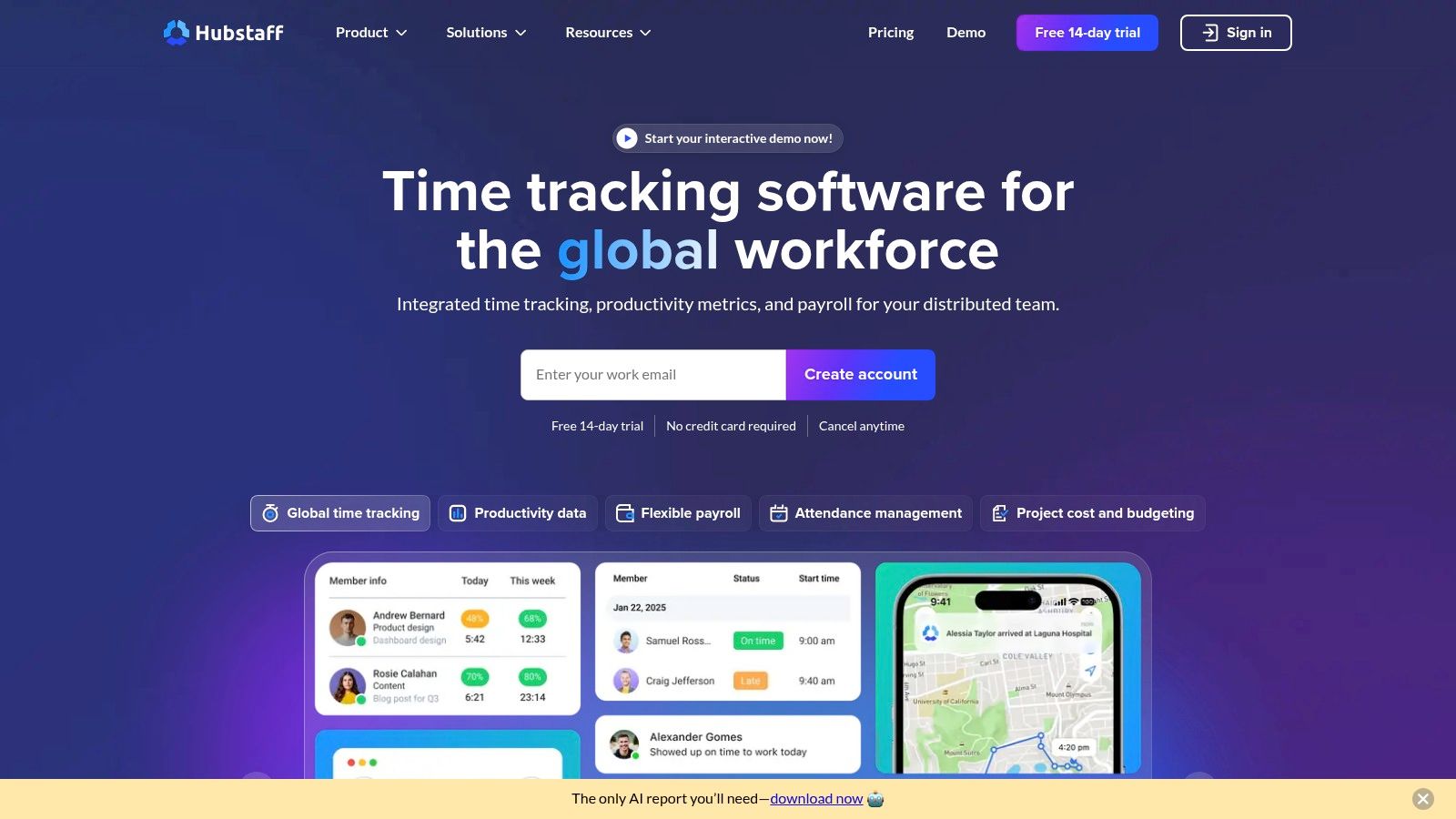
Key Features & Use Cases
Time Tracking with Activity Monitoring: Capture time spent on projects and tasks with optional screenshots and activity level reports, providing granular productivity insights.
Automated Payroll and Invoicing: Automatically generate payroll based on hours tracked or create client invoices, streamlining financial administration.
GPS Tracking: An essential feature for companies with field service or sales teams, allowing managers to track locations, time spent on-site, and mileage.
Integrations: Connects with over 30 popular project management and business tools, including Asana, Trello, and Jira, to centralize workflow data.
Analysis and Implementation
Hubstaff's greatest strength is its comprehensive suite of monitoring tools, which provides unmatched visibility into remote work patterns. However, these same features can be a double-edged sword. Implementing the screenshot or activity monitoring functionality requires a culture of trust and clear communication to avoid potential employee privacy concerns. The user interface, while functional, can feel less intuitive than some competitors, occasionally presenting a steeper learning curve for new users.
Pro Tip: Frame Hubstaff as a tool for personal productivity and focus rather than just for management oversight. Encourage employees to use their own data to identify peak working hours and minimize distractions, fostering a sense of empowerment. For those managing distributed teams, you can learn more about building trust with an offshore development team.
Website: https://hubstaff.com/
8. Teamwork
Teamwork is a comprehensive project management platform designed with client-facing work in mind, making it a standout choice among remote team management tools for agencies and service-based businesses. It provides an end-to-end solution that covers everything from initial project planning to final invoicing. This focus is crucial for remote teams that need to maintain tight collaboration with external stakeholders and demonstrate clear progress and value.
For managers overseeing client projects, such as a CTO managing an outsourced development team, Teamwork offers a centralized environment to track billable hours, manage budgets, and communicate effectively. Its structure ensures that both internal team members and clients have the visibility they need, reducing miscommunication and streamlining workflows. This is particularly beneficial in modern workforce models, such as staff augmentation for global talent, where transparency is key to a successful partnership.
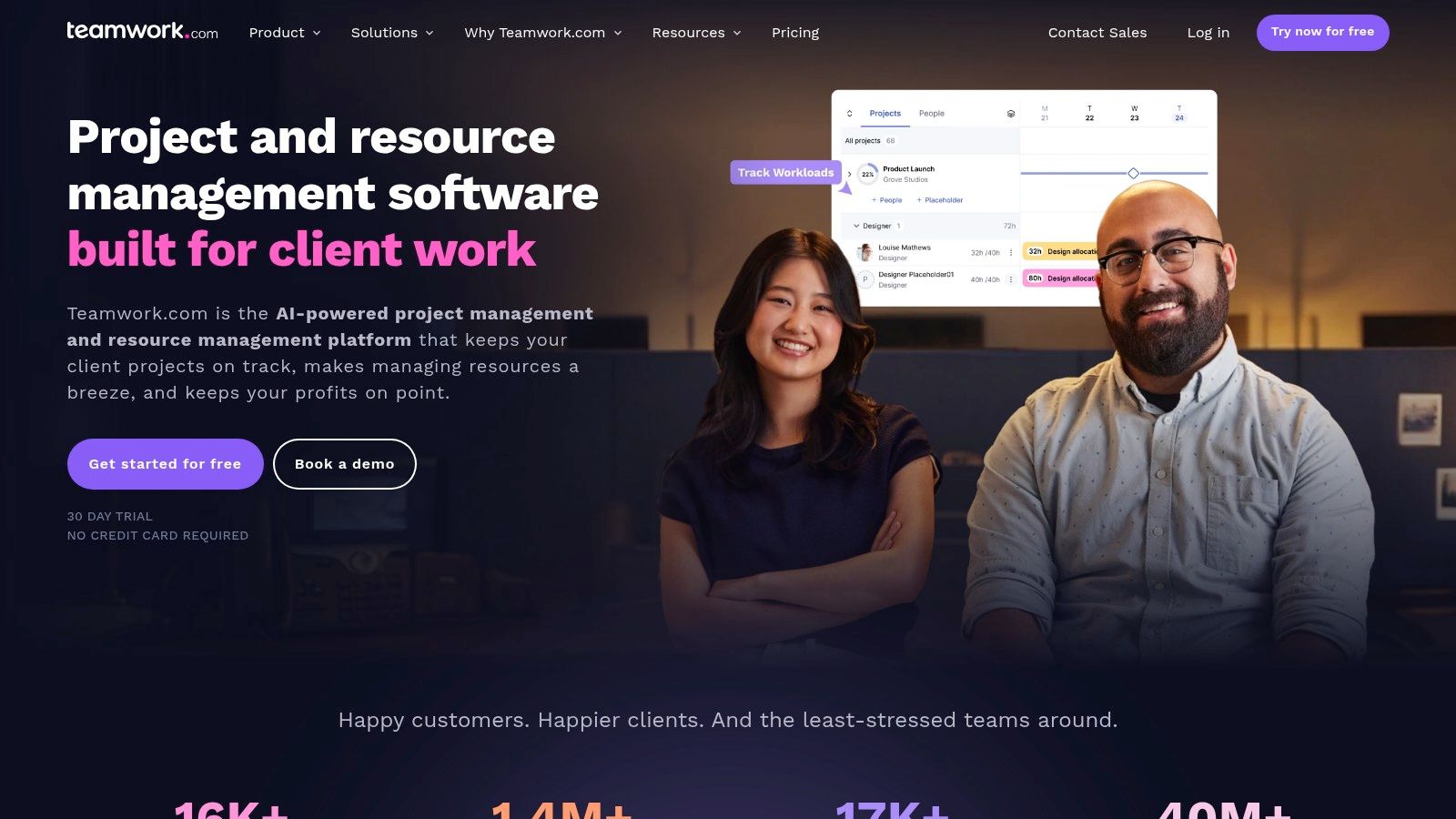
Key Features & Use Cases
Client Work Specialization: Features like time tracking, billing, and invoicing are built directly into the platform, eliminating the need for separate tools.
Flexible Project Views: Organize tasks using traditional lists, Kanban boards, or Gantt charts to suit different project methodologies and team preferences.
Robust Integrations: Connects with essential business software like HubSpot, Slack, and QuickBooks to create a unified workflow across sales, communication, and finance.
Analysis and Implementation
Teamwork’s user interface is clean and user-friendly, making adoption relatively smooth for new teams. Its greatest strength is its all-in-one nature for service delivery, which simplifies the tech stack for agencies. The free-forever plan is suitable for very small teams, but most businesses will need to upgrade to paid tiers to access critical features like project templates, billing, and advanced reporting.
Pro Tip: Use the "Notebooks" feature to create a centralized knowledge base for each project. This is perfect for storing project briefs, meeting notes, and client feedback, ensuring all remote team members have access to the same information source.
Website: https://www.teamwork.com/
9. Miro
Miro is a digital whiteboard platform that replicates the creative energy of an in-person workshop, making it one of the most essential remote team management tools for visual collaboration. It provides an infinite canvas where distributed teams can brainstorm, diagram complex systems, run retrospectives, and map out customer journeys in real-time. This is crucial for roles like Engineering Managers or UX Designers who rely on visual thinking to solve problems and communicate ideas.
For a Head of HR, Miro is invaluable for mapping out employee onboarding flows or organizing virtual team-building activities. The platform's strength lies in its ability to centralize unstructured ideation and give it form. Where other tools manage tasks, Miro manages the creative process that precedes the tasks, bridging a critical gap for remote teams who lack a shared physical space for spontaneous collaboration.
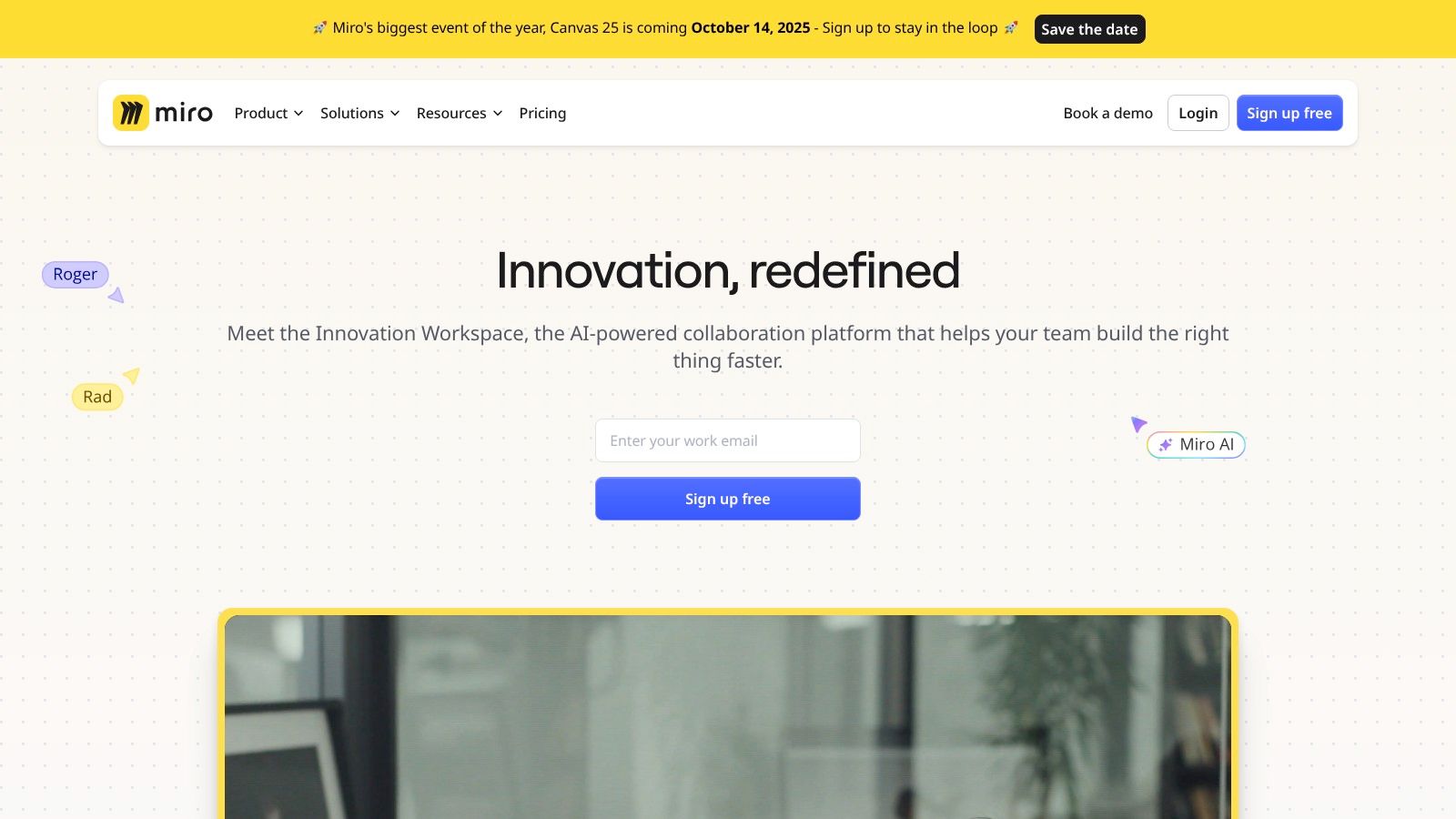
Key Features & Use Cases
Infinite Canvas & Templates: Start brainstorming instantly with pre-built templates for mind maps, Kanban boards, user story maps, and more, saving significant setup time.
Real-time Collaboration: Multiple users can co-edit, comment, and add sticky notes simultaneously, with cursors showing who is doing what, fostering a sense of shared presence.
Deep Integrations: Embed Miro boards directly into tools like Jira, Confluence, and Microsoft Teams, allowing visual plans to live alongside project tasks and documentation.
Analysis and Implementation
Miro’s free plan is generous, offering three editable boards, which is perfect for smaller teams or occasional use. However, for organizations that rely heavily on visual collaboration, paid plans are necessary to unlock unlimited boards, private board sharing, and advanced tools like voting and video chat. A potential downside is that large, complex boards can be resource-intensive, sometimes causing performance lags on older hardware.
Pro Tip: Use Miro to visualize complex global workforce structures, mapping out contingent labor, full-time employees, and staff augmentation partners. This visual aid helps leadership understand talent distribution and identify gaps, aligning with emerging trends in strategic workforce management.
Website: https://miro.com/
10. Zoom
Zoom has become synonymous with video conferencing, solidifying its place as an essential remote team management tool for synchronous communication. Its primary function is to facilitate real-time, face-to-face interaction, which is vital for maintaining personal connections and clarity in a distributed workforce. For roles like an HR Manager conducting interviews or a CTO leading a technical deep-dive, Zoom's reliable performance and high-quality video provide a stable environment for critical conversations that text-based tools cannot replicate.
The platform excels at recreating key in-office dynamics, from large all-hands meetings to intimate team huddles. It’s not just for meetings; it’s a versatile tool for virtual social events, one-on-one check-ins, and complex training sessions. For businesses leveraging global talent or contingent labor, Zoom bridges geographical divides, allowing seamless collaboration with staff augmentation partners and ensuring everyone feels present and included, regardless of location. Its simplicity ensures that even the least tech-savvy team members can join and participate without friction.
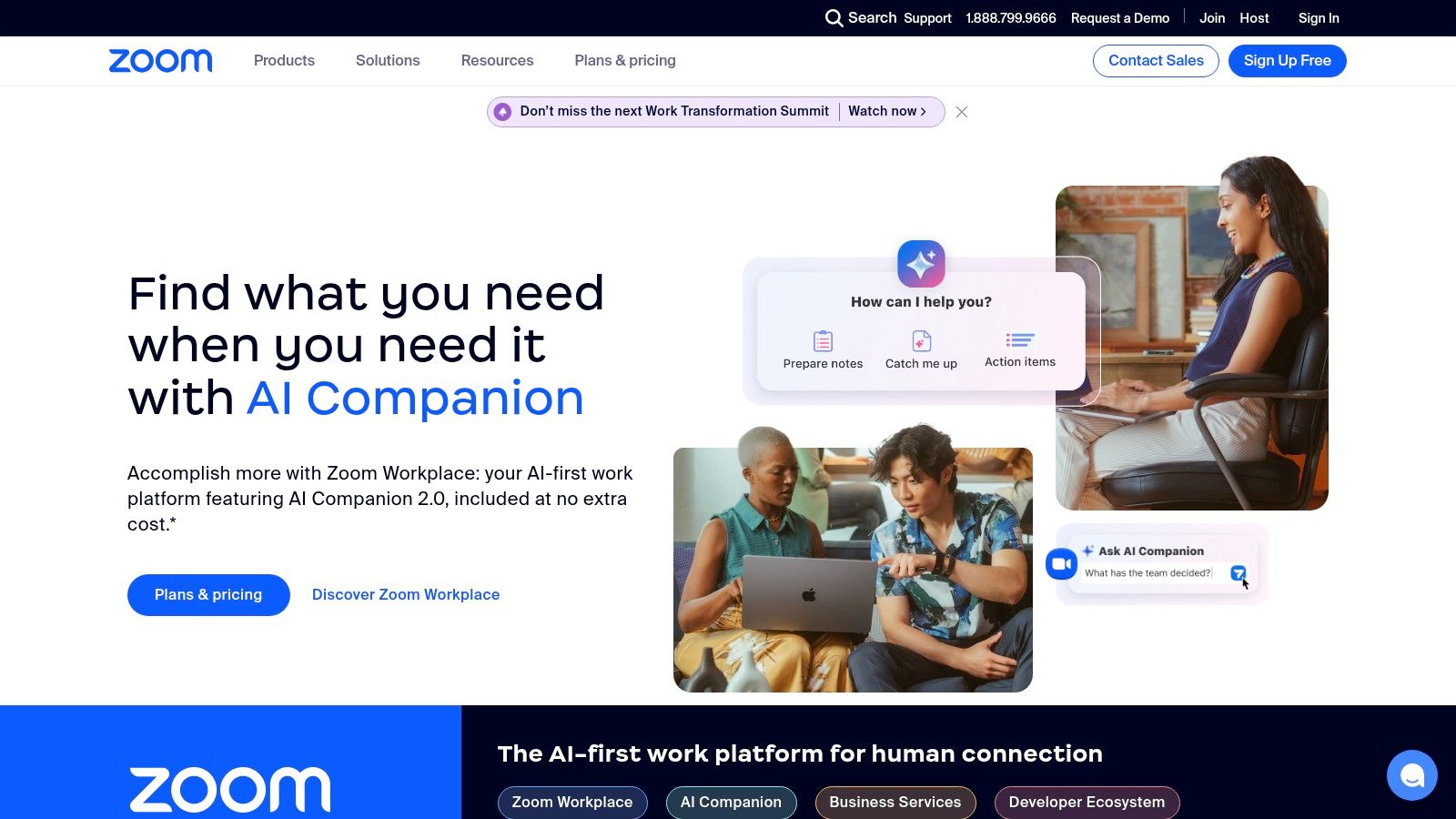
Key Features & Use Cases
Breakout Rooms: Split a large meeting into smaller, private groups for focused discussions, brainstorming sessions, or team-building activities, then bring everyone back together.
Screen Sharing and Annotation: Collaborate in real-time by sharing desktops, applications, or whiteboards, with tools for participants to draw, highlight, and comment directly on the shared content.
Integrations: Zoom integrates smoothly with calendar systems like Google Calendar and Outlook for easy scheduling, and connects with project management tools to link conversations to specific tasks.
Analysis and Implementation
Zoom's user-friendly interface is its greatest strength, making adoption effortless across an organization. The free tier is generous but imposes a 40-minute limit on group meetings, making paid plans necessary for most business use cases. While past security concerns have been largely addressed with enhanced encryption and privacy controls, it's crucial for organizations to configure settings properly.
The platform’s reliability under varying internet conditions makes it a top choice. However, it is fundamentally a communication tool, not a project management hub. It works best when paired with another platform that tracks asynchronous work and long-term goals.
Pro Tip: Use the recording and auto-transcription feature to create a searchable archive of important meetings. This helps accommodate different time zones and provides a valuable resource for team members who couldn't attend live, ensuring no one misses critical information.
Website: https://zoom.us/
11. Microsoft Teams
For organizations already embedded in the Microsoft ecosystem, Microsoft Teams serves as a powerful, all-in-one communication and collaboration hub. It stands out as one of the most integrated remote team management tools by weaving together persistent chat, video meetings, and file storage into a single interface. This eliminates the need for remote teams to constantly switch between different applications, reducing context-switching and streamlining workflows.
For roles like a CTO or Engineering Manager, the platform's deep integration with Microsoft 365 is its defining advantage. A team can co-author a Word document, update an Excel spreadsheet, or present a PowerPoint slide directly within a Teams channel or meeting. This unified environment is crucial for maintaining productivity and cohesion across a distributed workforce, ensuring everyone is working from the same set of tools and information.
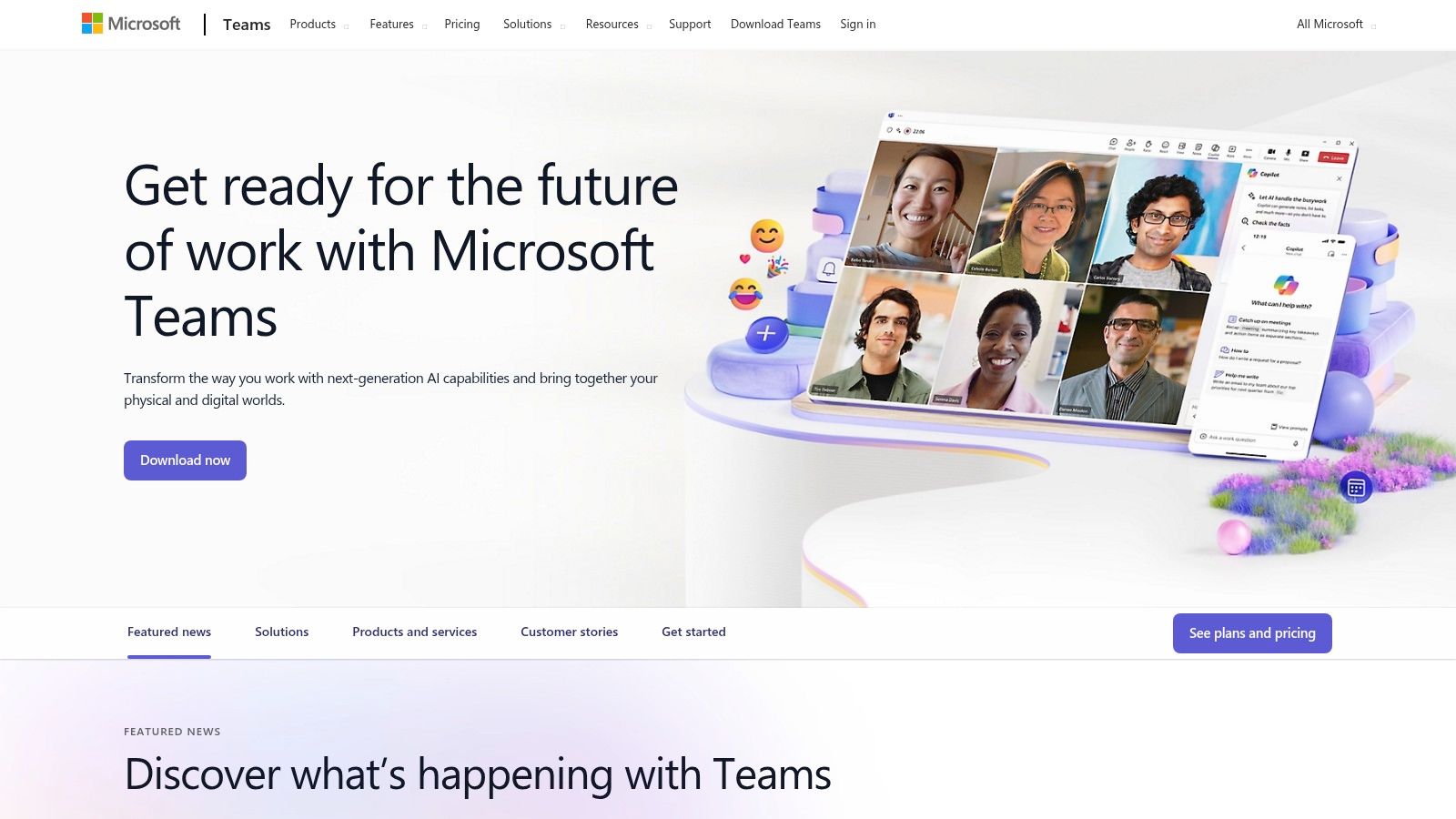
Key Features & Use Cases
Threaded Conversations: Keep discussions organized by replying directly to specific messages within a channel, making it easy to follow multiple topics without confusion.
Deep Office 365 Integration: Edit and collaborate on documents, spreadsheets, and presentations in real-time without ever leaving the Teams application.
Enterprise-Grade Security: Leverage Microsoft's robust security and compliance features, a critical requirement for midsize companies and enterprises handling sensitive data.
Analysis and Implementation
While Teams offers a comprehensive free version, its full potential is unlocked with a Microsoft 365 subscription, which is a key consideration for budget planning. The platform can feel complex to new users, and proper setup and governance are essential to prevent channel-sprawl and disorganization. A significant advantage is its emerging AI capabilities, like Copilot, which can summarize meetings and suggest action items, reflecting a key trend in workforce management technology.
Pro Tip: Use the "Wiki" tab in each channel to create a living document for team-specific information, like project goals, onboarding guides, or best practices. This creates a self-service knowledge base that empowers remote employees and reduces repetitive questions.
12. ProofHub
ProofHub positions itself as an all-in-one solution, consolidating multiple standalone apps into a single platform, which is a significant advantage for companies looking to simplify their tech stack. It's a highly practical choice among remote team management tools because it combines task management, team chat, file proofing, and time tracking under one roof. This integrated approach reduces context switching and ensures that all project-related communication and documentation are centralized and easily accessible.
For a CTO or Engineering Manager, the platform’s ability to switch between Kanban boards, Gantt charts, and calendar views offers the flexibility needed to manage both agile sprints and long-term project roadmaps. The built-in proofing tool is a standout feature, allowing marketing and design teams to annotate creative assets directly, streamlining the feedback and approval process for distributed teams and contingent labor forces.
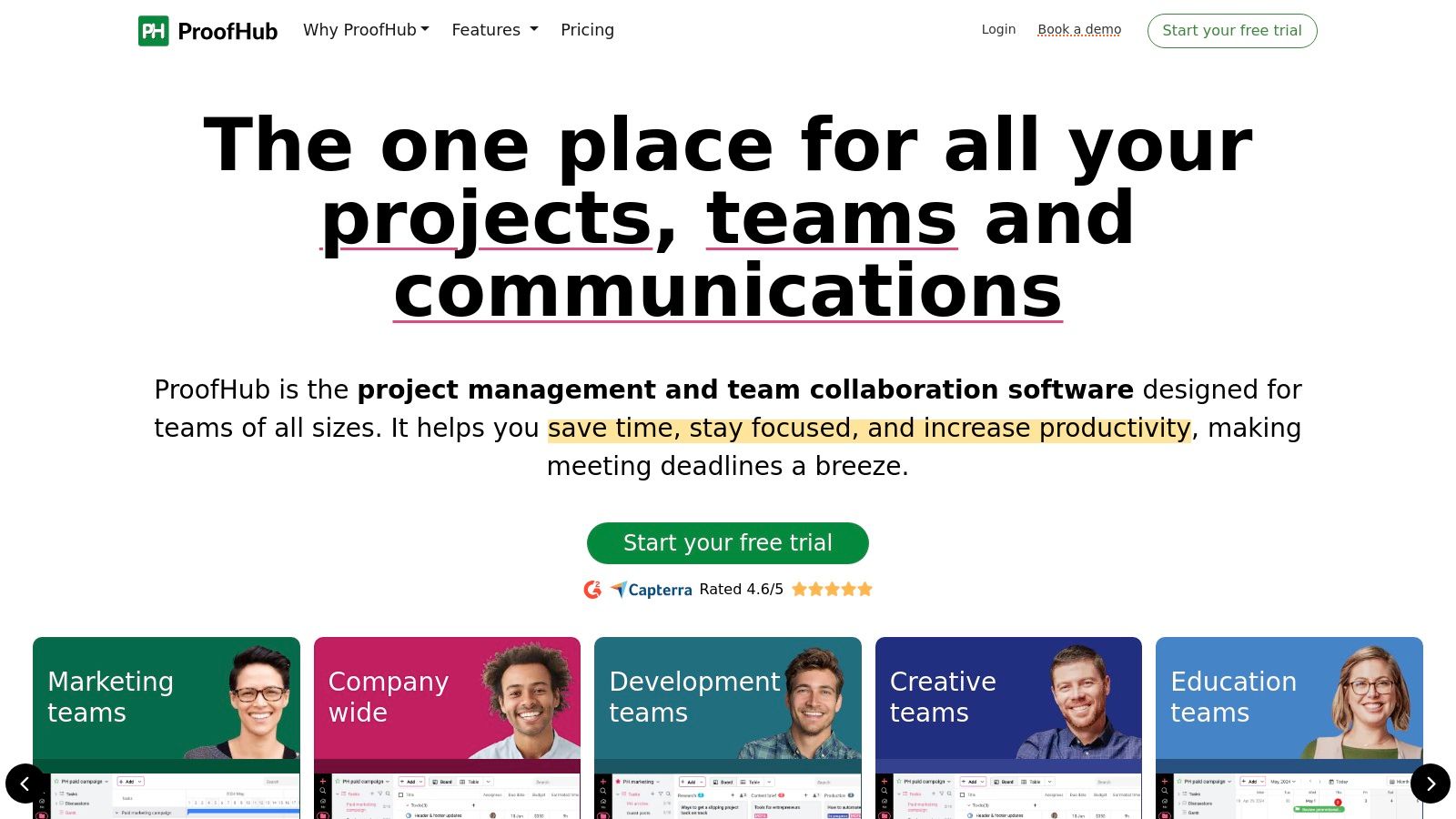
Key Features & Use Cases
Flat-Fee Pricing: ProofHub's pricing model is based on a flat monthly fee for unlimited users, making it exceptionally cost-effective for growing teams and midsize companies.
Integrated Proofing & Approvals: Directly comment on and approve designs, documents, and other files, which is ideal for creative, marketing, and legal teams.
Time Tracking and Reporting: Native time tracking allows managers to monitor project budgets and employee productivity, generating reports to analyze resource allocation.
Analysis and Implementation
ProofHub’s greatest strength is its value proposition: a comprehensive feature set without the per-user fees common to its competitors. The interface is clean and generally user-friendly, minimizing the onboarding curve for new team members. However, its primary limitation lies in its integration capabilities; it offers far fewer connections to third-party apps compared to platforms like Asana or Jira. Additionally, while the mobile app covers basic functions, its functionality is less robust than the desktop version.
Pro Tip: Use the "Discussions" feature to create dedicated forums for specific projects or topics. This helps keep conversations organized and separate from the more informal real-time chat, ensuring important decisions and context are not lost in the stream of daily messages.
Website: https://www.proofhub.com/
Top 12 Remote Team Management Tools Comparison
Platform | Core Features | User Experience / Quality Metrics | Value Proposition | Target Audience | Price Points / Unique Selling Points |
|---|---|---|---|---|---|
shorepod | Global vetted engineers, full hiring & team mgmt | Fast access (<24h), full lifecycle control | Lowest cost guarantee, risk-free pricing | Startups & mid-sized tech companies | All-in-one TaaS, EOR & compliance, trusted by Rivian |
Asana | Task/project mgmt, multiple views, integrations | User-friendly, robust integrations | Free version for small teams | Remote & structured workflow teams | Tiered plans, advanced features in higher tiers |
Slack | Channel messaging, app integrations, file sharing | Real-time communication, mobile accessibility | Improves collaboration, reduces email | Remote teams needing chat | Free plan limitations, highly customizable |
Trello | Kanban boards, automation, app integrations | Intuitive, visual, easy to use | Free version with essential features | Teams prioritizing visual workflows | Power-Ups require paid plans |
Monday.com | Custom workflows, automation, integrations | Flexible, visually appealing | Streamlines processes | Versatile teams & workflows | Higher pricing, feature-rich |
ClickUp | Multiple views, customizable tasks, integrations | Highly customizable, all-in-one platform | Replaces multiple tools | Teams needing comprehensive tools | Free plan available, steeper learning curve |
Hubstaff | Time tracking, employee & GPS monitoring | Productivity insights, payroll automation | Workforce management for remote teams | Remote & field teams | Privacy concerns, interface less intuitive |
Teamwork | Task & time tracking, invoicing, integrations | User-friendly, client-focused | End-to-end project mgmt for agencies | Client work & agencies | Advanced features require higher tiers |
Miro | Infinite canvas, templates, integrations | Real-time collaboration, co-editing | Visual collaboration for distributed teams | Creative & planning teams | Free version, resource-intensive |
Zoom | HD video/audio, breakout rooms, calendar integration | Reliable, easy scheduling | High-quality video meetings and webinars | Remote communication | Free limit 40 mins, some security concerns |
Microsoft Teams | Chat, video, file storage, MS 365 integration | Enterprise security, comprehensive features | All-in-one Microsoft collaboration platform | Enterprise & Microsoft users | Requires MS 365 subscription, complex setup |
ProofHub | Task mgmt, chat, time tracking | Simple, flat pricing | All-in-one without per-user fees | Remote teams | Limited integrations, less robust mobile app |
Building Your Tech Stack for the Future of Work
Navigating the expansive landscape of remote team management tools can feel overwhelming. As we've explored through detailed analyses of platforms like Asana, Slack, Miro, and more, the objective is not to find a single, mythical "best" application. Instead, the goal is to strategically construct a cohesive, integrated technology stack that empowers your team, streamlines workflows, and directly supports your organization's unique operational DNA and strategic objectives. The right combination of tools acts as the digital headquarters for your distributed workforce, fostering clarity, collaboration, and a strong sense of connection regardless of physical location.
The tools detailed in this guide, from the visual Kanban boards of Trello to the comprehensive work OS of Monday.com, each offer distinct advantages. Your selection process should be a deliberate exercise in matching features to specific pain points. A fast-moving startup might prioritize the flexibility and all-in-one nature of ClickUp, while a larger enterprise may lean on the robust security and integration capabilities of Microsoft Teams. The key is to move beyond marketing claims and focus on the practical realities of implementation and daily use.
From Tools to Strategy: Key Takeaways
As you finalize your decisions, remember that the tool is only part of the equation. A successful remote work environment hinges on the strategy and culture you build around your technology. The most powerful remote team management tools will fail if not supported by clear communication protocols, well-defined processes, and a culture of trust and accountability.
Consider these core principles as you move forward:
Integration Over Isolation: The most effective tech stacks are interconnected ecosystems. Before committing to a new tool, rigorously evaluate its ability to integrate with your existing systems. A seamless flow of information between your project management software, communication hub, and time-tracking app eliminates friction and creates a single source of truth.
Adoption is Everything: A tool is only valuable if your team uses it correctly and consistently. Prioritize platforms with intuitive user interfaces and provide comprehensive training and clear documentation. Run a pilot program with a small, engaged group to gather feedback and champion adoption across the wider organization.
Scalability for Tomorrow: Your company's needs will evolve. Select tools that can grow with you, whether that means accommodating more users, handling more complex projects, or offering advanced features you may need in the future. Avoid getting locked into a system that will limit your growth potential.
The Emerging Frontier: AI, Talent, and Technology
Looking ahead, the evolution of remote team management tools is inextricably linked to emerging trends in workforce management. The most significant shift is the integration of Artificial Intelligence (AI) to automate routine tasks, provide predictive insights on project timelines, and even analyze team communication patterns to identify potential burnout or disengagement.
Simultaneously, the very definition of a "team" is expanding. The rise of the contingent workforce and specialized global talent means that your management stack must be agile enough to onboard, manage, and collaborate with a blended team of full-time employees, freelancers, and contractors. This is where a new generation of workforce solutions comes into play, blurring the lines between talent acquisition and daily operations. The future isn't just about managing projects; it's about seamlessly integrating global talent into your core workflows, powered by intelligent technology. The smartest companies are already building their stacks with this future in mind, recognizing that access to global talent is their ultimate competitive advantage.
Ready to build a world-class remote team without the operational overhead? shorepod provides a new kind of staff augmentation, connecting you with elite global talent in development, design, and more, all managed through a streamlined platform. Visit shorepod to discover how we integrate top-tier professionals directly into your team, complete with the tools and support they need to succeed from day one.
Comments